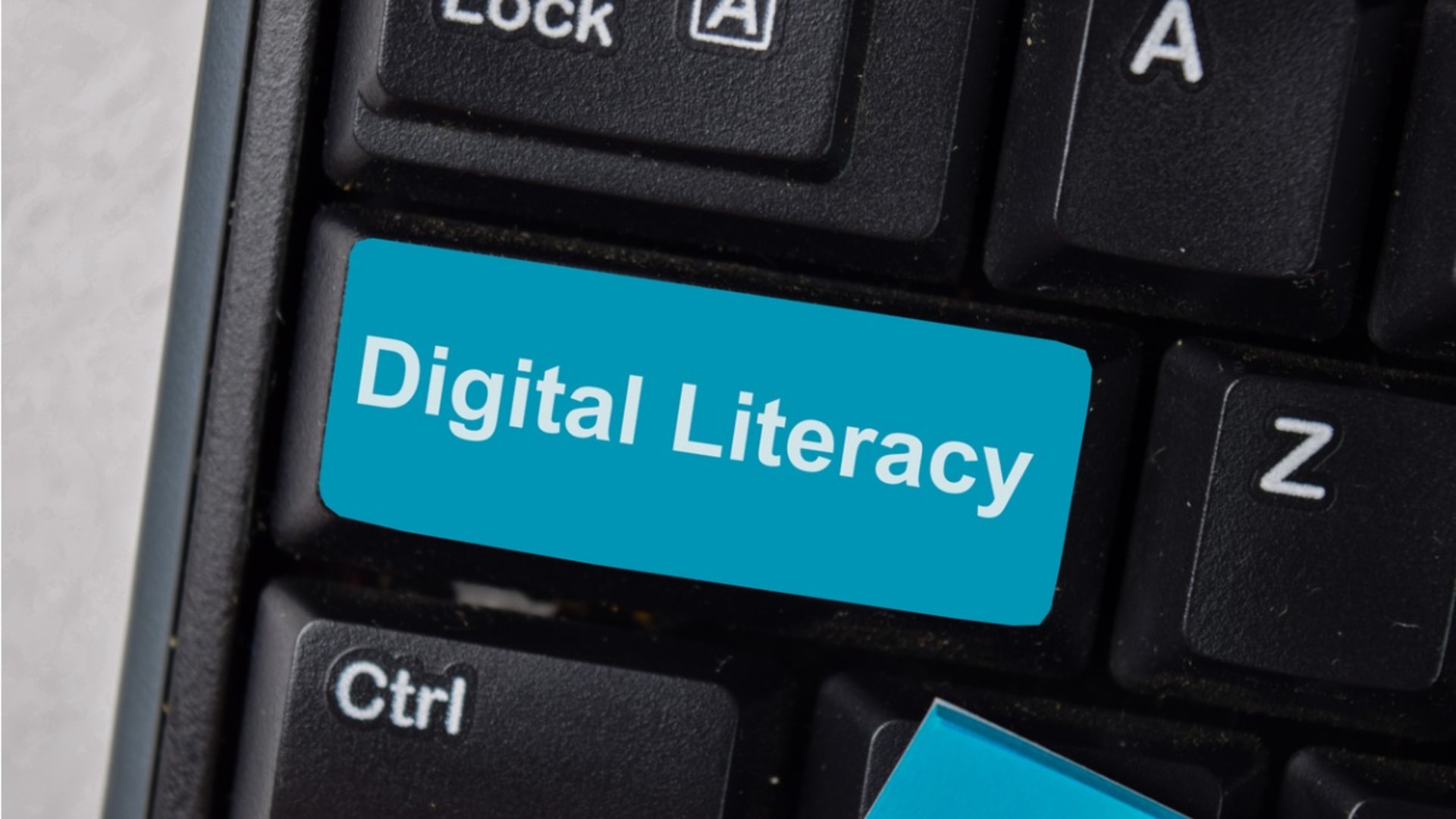Digital literacy is the understanding and proficient use of technology-based tools, electronic devices, communication systems, and computer networks. It includes an understanding of computers and the internet, how to browse websites and applications, how to create and consume digital material, and the capacity to use these tools for a variety of reasons, including research, problem solving, communication, entertainment, and productivity. In other words, digital literacy encompasses both the ability to use technology effectively and to appreciate its ramifications for our life.
The significance of digital literacy as a vital component of our daily lives is becoming increasingly apparent. We have all become dependent on technology to be informed, connected, and productive as a result of its ever-increasing presence in our lives. Those who are digitally literate have a significant edge over those who are not, as technology is advancing and becoming more ingrained in our lives at an accelerating rate.
Digital literacy impacts all types of businesses, from small local businesses to multinational corporations, because it influences how well they can leverage contemporary technology to efficiently offer products/services or maintain market competitiveness.
The newest technology gives businesses both new opportunities and possible pitfalls if employees and customers lack sufficient awareness about them. For instance, digitally savvy customers today expect companies to use innovative web tools for customer service or provide comprehensive online product information. If this condition is not met, companies can quickly lose sales or reputation points due to negative online reviews from dissatisfied customers.
Moreover, without enough digital literacy, firms may miss out on opportunities such as online marketing campaigns or joint ventures with other organizations due to a lack of understanding of how new technologies function.
Hence, it is crucial for businesses to ensure that their staff possess a certain level of digital literacy so that they can exploit developing technology for their specific business operations, thus ensuring long-term increases in productivity and profitability.
But what happens when we lack the knowledge and resources to work with technology?
What is Digital Illiteracy?
Digital illiteracy is the absence of information, skills, or comprehension regarding the utilization of digital tools and technology to complete a task. This lack of literacy can prohibit persons from using a computer, smartphone, or other electronic devices to obtain online information or communicate with others.
It may also involve a difficulty in operating software like web browsers and word processors properly. In short, digital illiteracy is the inability to comprehend or correctly employ digital devices such as smartphones, tablets, laptops, and desktop computers.
The problem of digital illiteracy may involve issues such as lack of access to the devices and hardware required for using technology (e.g., missing power cords), lack of access to the internet (e.g., due to location in rural areas or high monthly costs), and limited understanding of how to configure settings on a device (e.g., Wi-Fi connection settings) or use software applications (e.g., virus protection software).
It could also involve not knowing how to locate trustworthy information online, recognize reputable websites (e.g., avoiding fake news), secure one’s personal data while surfing the web (e.g., passwords/private information), or sign up/purchase products online safely (e.g., entering credit card information).
Many individuals with low levels of digital literacy experience social isolation due to their inability to keep up with friends and family who are more tech-savvy. They also experience limited employment opportunities since many job postings now require some level of tech proficiency, without which they are unable to apply for positions that match their interests and qualifications. This sort of cybercrime has increased significantly in recent years, causing victims all around the world to incur financial losses.
In short, a person’s level of digital literacy significantly impacts their ability to operate within the current environment, which is increasingly tech-driven and heavily reliant on digital tools for communication and productivity purposes. Knowing how to correctly utilize these technologies is an essential skill for those wishing to remain competitive in the modern world.
The Impact of Digital Illiteracy on Business Outcomes
Digital illiteracy has a tremendous effect on company results. A lack of awareness and engagement with digital technology has numerous negative repercussions, including lost productivity, increased expenses, and the risk of falling behind competitors.
- Loss of Productivity
Digital illiteracy inside a business might result in a considerable drop in production. If employees lack the knowledge necessary to utilize the available digital technologies, their rate of productivity can decrease dramatically. This can result in tasks taking longer than necessary to complete and a higher error rate. A lack of digital literacy can also inhibit communication within a team and between departments, as employees are unable to use technology effectively to communicate information or cooperate on projects.
- Increasing Prices
The costs associated with a workforce deficient in digital skills might be substantial. Companies will need to invest in staff training programs as well as new software and other technology that can allow smoother cooperation and enhanced productivity. Moreover, if they lack these talents internally, firms must evaluate the expense of acquiring workers who are already skilled with digital technologies.
- Run the Risk of Falling Behind Rivals
Lastly, firms that do not address the issue of digital illiteracy run the risk of slipping behind their competitors who have embraced new technology and invested in training their personnel to use them effectively. In today’s digitally-driven economy, organizations operating in any area or industry would be at a significant disadvantage if they failed to keep up with technological developments or understand how they may be utilized effectively.
Despite these potential effects of digital illiteracy on businesses, there are still solutions available that enable organizations to foster an environment in which employees feel comfortable using and interacting with the latest technologies without significantly increasing costs or falling behind the competition due to a lack of knowledge or skill sets related to digital tools and applications.
By investing in digital literacy training for employees and continuously analyzing and updating organizational technology as new innovations emerge, organizations may ensure their competitiveness and prevent any negative effects stemming from low levels of digital proficiency among their personnel.
How to Address Digital Illiteracy in the Workplace
Digital illiteracy in the workplace can be addressed through a combination of strategies. These strategies should include but not be limited to:
- Coaching and Training: Companies should give employees formal or informal opportunities to acquire digital skills through coaching and training. This can include offering access to online resources such as tutorials and instructional films, as well as investing in programs or courses that enable employees to expand their digital skills. Employers can also encourage their employees to participate in online forums where they may learn from one another, exchange ideas, and practice their newly acquired abilities.
- Creation of Digital Learning Paths: Companies should establish digital learning paths for individual departments or teams to increase employees’ proficiency with digital tools and systems. These pathways should be adapted to the organization’s needs, its teams/departments, and each employee’s present talents. Each path should include specified goals for each employee’s progress over time, such as obtaining particular certifications or attaining specific skill levels with particular tools and applications.
- Mentorship: Companies should also attempt to build mentorship programs between individuals who have more expertise with technology and those who are still learning or want further assistance. Employers can ensure smoother adoption of digital skills and increase collaboration within the firm by linking new users with seasoned ones.
- Evaluation and Feedback: Periodically assessing employees’ digital literacy is critical for detecting knowledge or skill gaps and providing focused improvement options. This can be accomplished through individual interviews performed by supervisors, staff-wide surveys, or even tests of technical proficiency in various areas, such as programming languages and office software suites. Regarding the appropriate use of technology in the workplace, feedback is vital for encouraging continued growth and development among staff members, regardless of the evaluation method employed.
Strategies for Overcoming Digital Illiteracy and Maximizing Business Growth
Digital literacy is vital for the success of modern enterprises. Organizations must prioritize digital literacy if they wish to remain competitive in the rapidly evolving digital environment. Five solutions for overcoming digital illiteracy and increasing business growth are outlined below.
Invest in Training: Ensure that your personnel remains current with the newest technologies. By offering access to basic computer skills training, you can help bridge the divide between individuals who have adopted digital literacy skills and those who have not. From web design and coding classes to basic office suite programs, this form of training can assist employees’ comprehension of the influence of technology on their jobs.
Utilize Educational Resources: With so much material available online, there are numerous ways to educate your workers on digital literacy-related topics. There are numerous free learning resources accessible, in addition to more extensive e-courses that provide complete teaching on programming, web development, and other topics. Integrating instructional resources into your onboarding procedure is an excellent approach to ensure that everyone in your firm has the same understanding of how to utilize technology effectively.
Create a Mentorship Program: Providing a mentorship program to employees might be advantageous for both sides. New hires can learn from more seasoned experts who have been exposed to more modern technologies over time. Seasoned employees can impart their knowledge of digital skill sets like coding and analytics. Creating a mentorship program also fosters an environment where junior staff employees can ask questions about their technology responsibilities without fear of ridicule or shame.
Promote Curiosity: Encourage staff to be curious about technology and keep up with industry developments, so they don’t fall behind in their knowledge base or ability to use emerging software programs or tools. Offering incentives, such as prizes or additional training opportunities, will motivate them to stay abreast of industry innovations, resulting in an increase in organizational efficiency as a whole.
Implement Gamification Techniques: Gamification approaches entail transforming routine duties into learning opportunities through play-like activities such as games or contests that award success points when particular goals are accomplished by individuals or teams in an organization. By incorporating gamification into the workplace, you create an environment in which team members are driven and enthusiastic about learning a variety of digital skills, hence increasing the company’s total productivity.
How to Develop Software for a Digitally Illiterate Audience
Developing software for a digitally illiterate audience is not an easy endeavor, but it is possible with patience and careful design. Here are some guidelines for building software for an audience with limited digital literacy:
- Start with a simple user interface, free of complicated navigation and menus. While designing the interface, consider the possibility that users have never used a computer. Employ as little verbiage as possible, restrict options, and make it as intuitive as feasible.
- Before distributing the product, it should be tested by people of the target demographic. Request that they perform easy tasks and record any difficulties they encounter. Utilize this feedback to enhance your performance.
- Recognize that digital literacy is a struggle when completing a complex digital literacy assignment. It is essential to ensure that the user does not feel overwhelmed. Make sure the user is aware of where they are in the process by decomposing difficult tasks into a few fundamental steps.
- Provide visual clues to assist users in comprehending the interface and guiding them through the activity. Use arrows to indicate the direction of a task or a progress bar to represent the user’s progress through the task.
- Create an online assistance system that guides users through the process step-by-step. The support system should be straightforward and geared at facilitating the completion of the activity as quickly and easily as feasible.
- Provide members of the target audience with training and education. This will help employees grow more familiar with the task and software, and it should be considered a continuous activity after the first product launch.
- Take into account the variety of devices users may employ. Consider how various input methods (mouse, keyboard, touch, etc.) will impact the user experience when designing the interface.
- Provide tools that are adaptable and provide users with useful feedback. This may involve offering context-sensitive and customizable assistance, notifying users when information is insufficient, assisting them in avoiding errors and providing additional assistance for challenging activities.
- Automating complicated tasks, such as data entry and searches, can simplify the user experience. If users can submit data in different ways (for example, by dictating or using their native language), the software must be able to accurately understand the data.
- Document the product in such a way that the user can refer to it for help. Visuals, examples, and keyword searches should be included in quality documentation.
It is possible to design software for a digitally illiterate audience with time and strategy. By considering their requirements in the design and user experience, it is possible to create intuitive, accessible, and efficient software.
Why Should a Tech Company Target a Digitally Illiterate Audience?
The global digital ecosystem continues to evolve swiftly. This has created an excellent opportunity for technology companies to reach an audience that is no longer technologically competent. Particularly, tech enterprises should target or provide services to a digitally illiterate audience. This audience has the potential to expand the consumer base and increase profits if it is targeted.
Initially, targeting a digitally illiterate population can assist IT companies in penetrating new industries that have not yet been fully explored. Offering new products and services on a continual basis, the technology sector is evolving at a record rate.
Regrettably, not all of these offerings are accessible to all individuals. Addressing the digitally illiterate audience can help tech companies contact more people and develop products and services tailored to those who may not comprehend the existing offering.
Addressing a digitally illiterate demographic can help IT companies promote their products and services more successfully. Tech organizations must be resourceful in order to acquire a competitive advantage in the digital world. Providing products and services that are specifically geared for technologically illiterate customers can help IT companies stand out from the competition.
In addition, by targeting the digitally illiterate public, tech businesses can employ a variety of techniques, such as promotions and partnerships, to grab this untapped market.
Furthermore, by addressing the digitally illiterate demographic, technology companies can create more user-friendly and accessible products. This can aid in enhancing the user experience and gaining feedback from users with useful insights. Addressing a technologically illiterate demographic can also help IT companies better comprehend the demands and preferences of their clients.
Since the IT business continues to grow, it is essential to understand user requirements and preferences in order to stay ahead of the competition.
Additionally, engaging a digitally illiterate audience has the potential to enhance tech companies’ revenue streams. Targeting this demographic can provide the opportunity to develop products that can be offered for a greater price.
Also, these items can be utilized as marketing tools to promote the tech company’s brand.Targeting a technologically illiterate audience might present tech companies with an opportunity to mold the future of technology by providing customized products and services.
In summary, targeting a digitally illiterate audience provides tech companies with the opportunity to enter untapped markets and create more user-friendly and accessible products. It also enables tech companies to employ a variety of marketing methods, expand revenue streams, and gain a deeper understanding of their clients. By focusing on a digitally illiterate audience, IT companies can develop a stronger foundation and future success.







